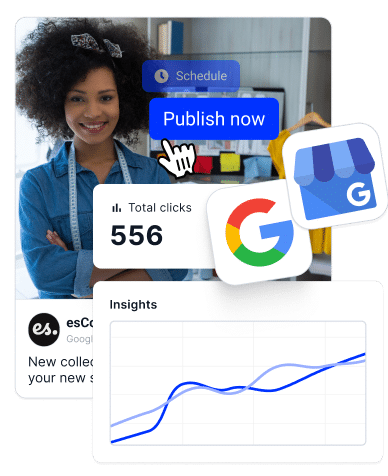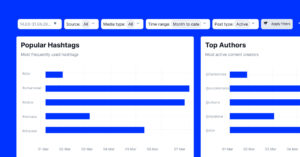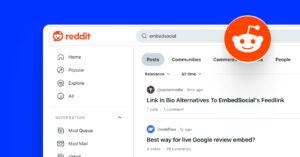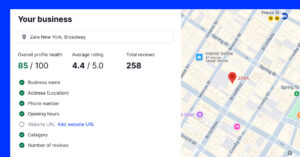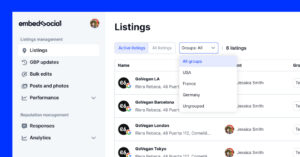Il est plus important que jamais que votre entreprise soit remarquée par les clients locaux, et l'un des meilleurs moyens d'y parvenir est d'établir une solide liste d'entreprises locales.
Que vous soyez propriétaire d'une petite entreprise ou que vous gériez une entreprise de l'Union européenne, vous avez besoin d'une aide financière. plusieurs sites sur votre profil Google BusinessIl est donc essentiel de disposer d'informations précises dans tous les principaux annuaires de votre secteur d'activité. Après tout, cela renforce considérablement votre référencement local et accroît votre visibilité.
Alors, comment créer votre liste d'entreprises et quel service de liste d'entreprises locales devriez-vous utiliser ? Je vous explique ci-dessous tout ce que vous devez savoir sur la gestion des listes d'entreprises locales et je vous indique où enregistrer vos informations pour une visibilité maximale.
Prêt à entrer en contact avec les clients locaux qui recherchent vos services ?
Qu'est-ce qu'une liste d'entreprises locales ?
Définition: Une liste d'entreprises locales est une profil en ligne contenant des informations clés sur votre entrepriseIl apparaît généralement dans les moteurs de recherche, les annuaires d'entreprises locales, diverses plateformes de cartes, etc.
Les listes d'entreprises locales sont crucial pour améliorer votre visibilité dans les résultats de recherche locauxVous augmentez vos chances d'apparaître dans les recherches locales en inscrivant votre entreprise sur plusieurs plateformes, ce qui génère plus de trafic et de profits.
Pourquoi les listes d'entreprises locales sont-elles importantes pour le référencement ?
Les listes d'entreprises locales sont bien plus qu'un simple carnet d'adresses numérique, car elles jouent un rôle crucial dans votre stratégie globale de référencement. Voici pourquoi elles sont importantes :

- Améliorer le classement dans les moteurs de recherche locaux-Les moteurs de recherche comme Google utilisent les listes locales comme facteur clé pour déterminer quelles entreprises apparaissent dans les résultats de la recherche locale ;
- Améliorer la visibilité dans Google Maps-Une fiche d'entreprise précise et optimisée augmente les chances de votre entreprise d'apparaître dans Google Maps et d'améliorer votre image de marque. Google Maps marketingpour que les clients puissent vous trouver plus facilement ;
- Augmenter les citations locales-Chaque inscription est une citation qui renforce la présence en ligne de votre entreprise et aide les moteurs de recherche à vérifier vos données et à s'y fier ;
- Améliorer la cohérence des PAN-La cohérence de votre nom, de votre adresse et de votre numéro de téléphone (NAP) dans toutes les listes est essentielle pour le référencement et pour ne pas créer de confusion dans les moteurs de recherche ;
- Optimiser les mots-clésDe nombreux annuaires vous permettent d'inclure des mots-clés dans la description de votre entreprise, ce qui peut vous aider à obtenir un meilleur classement pour certaines recherches ;
- Générer du trafic à partir de sources multiples-En étant référencé sur différentes plateformes, vous captez aussi directement le trafic des utilisateurs de l'annuaire ;
- Impact sur la confiance des clients-des listes en ligne précises et complètes font apparaître votre entreprise comme plus crédible et plus digne de confiance aux yeux des clients potentiels ;
- Encourager les commentaires des clients-Les inscriptions sur des plateformes telles que Google My Business et Yelp permettent souvent aux clients de laisser des commentaires, qui non seulement influencent les clients potentiels, mais fournissent également de nombreuses informations sur les activités de l'entreprise. preuve sociale via contenu généré par l'utilisateur;
- Gérer la réputation en ligne-la mise à jour et la surveillance régulières de vos listes locales vous aident à contrôler vos gestion de la réputation en ligne efforts ;
- Faciliter la visibilité de la recherche mobile-L'inscription de votre entreprise dans des annuaires adaptés aux mobiles est essentielle pour attirer les clients en déplacement de nos jours.
L'intégration de listes d'entreprises locales dans votre stratégie de référencement est essentielle pour garantir que votre entreprise soit bien classée et qu'elle se distingue sur le marché local concurrentiel.
Comment créer une liste d'entreprises locales ?
La création de listes d'entreprises locales est un processus très simple :
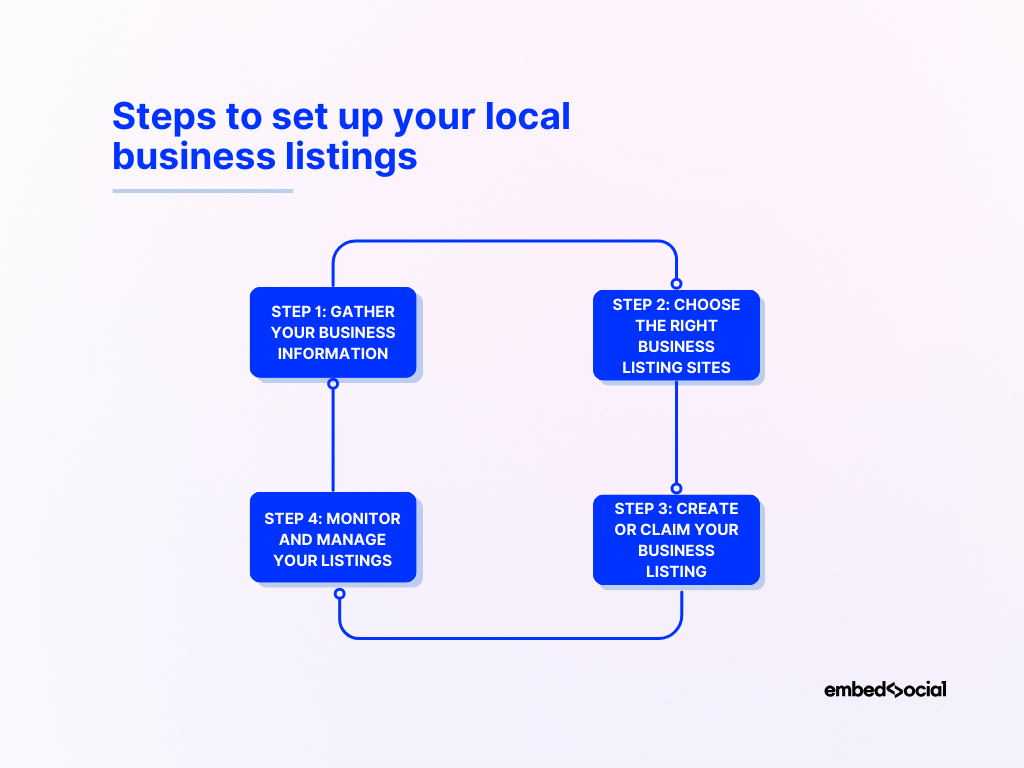
Étape 1 : Recueillir des informations sur votre entreprise
Lorsque vous souhaitez créer une liste locale pour votre entreprise, vous devez collecter différents types d'informations, y compris mais sans s'y limiter :
- Nom, adresse et numéro de téléphone (NAP)-Vous devez toujours inclure ces détails sur chaque site d'inscription et veiller à ce qu'ils soient exacts et cohérents partout ;
- Heures d'ouverture-Deuxièmement, vous devez également indiquer vos heures d'ouverture afin d'informer les clients de la date à laquelle vous êtes ouvert ;
- URL du site web-Bien entendu, si vous souhaitez qu'ils visitent votre site web, incluez un lien pour augmenter le trafic et fournir des informations supplémentaires ;
- Catégories d'entreprises-Tout aussi important que votre NAP, vous devez également choisir la catégorie pertinente qui décrit le mieux votre entreprise ;
- Description de l'entreprise-Soyez aussi concis et précis que possible en mettant en évidence votre offre commerciale à l'aide de descriptions riches en mots-clés ;
- Photos et logos de haute qualité-Chaque client moderne veut voir des images de votre entreprise, alors incluez des images de haute qualité pour attirer l'attention ;
- Modes de paiement-Si vous vendez des produits ou des services, indiquez les modes de paiement acceptés afin d'informer les clients des choix qui s'offrent à eux ;
- Liens vers les médias sociaux-Enfin, ajoutez des liens vers vos profils de médias sociaux afin d'entrer en contact avec vos clients sur différentes plateformes.
Les informations ci-dessus sont plus ou moins obligatoires sur la plupart des sites d'inscription d'entreprises locales. Cela dit, selon le site, il se peut que l'on vous demande d'ajouter des informations supplémentaires.
Étape 2 : Choisir les bons sites de référencement d'entreprises
Il est essentiel de sélectionner les bons sites d'inscription des entreprises pour atteindre efficacement votre public cible et améliorer votre visibilité au niveau local. Après tout, les plateformes choisies doivent s'aligner sur votre secteur d'activité et sur les caractéristiques démographiques spécifiques que vous souhaitez attirer.
Par exemple, si vous travaillez dans le secteur de l'hôtellerie, des sites comme TripAdvisor sont essentiels pour entrer en contact avec les voyageurs. En revanche, les entreprises de services, comme les plombiers, trouvent plus de valeur dans des plateformes comme Angi, car elles couvrent les fournisseurs de services locaux.
En outre, les popularité et base d'utilisateurs de chaque plateforme doit être prise en compte.
L'inscription de votre entreprise sur des annuaires très répandus tels que Google Business Profile et Yelp vous permet d'être visible auprès d'un large public. Toutefois, ne négligez pas les plateformes de niche qui s'adressent à votre secteur d'activité, car elles peuvent également s'avérer très utiles.
Étape 3 : Créez ou réclamez votre fiche d'entreprise
Ensuite, vous devez ajouter vos inscriptions locales à divers annuaires et, bien que le processus soit similaire partout, il se peut que vous deviez suivre des étapes spécifiques.
Cela dit, il y a généralement quatre étapes simples à suivre :
- Identifiez les plateformes sur lesquelles vous souhaitez faire figurer votre entreprise - Les options les plus courantes sont Google Business Profile, Yelp et Bing Places for Business. Une fois que vous avez sélectionné vos plates-formes, accédez à la section "Entreprises" du site web. Par exemple, si vous créez un profil professionnel Google, commencez par visiter la page d'accueil du profil professionnel Google ;
- Recherchez le nom de votre entreprise dans l'annuaire - vérifier s'il existe déjà une liste pour votre entreprise, et si c'est le cas, vous devez la réclamer. Cela implique de vérifier votre identité en tant que propriétaire de l'entreprise par un appel téléphonique, un courrier électronique ou une carte postale ;
- Créer un nouveau profil s'il n'existe pas de liste - le processus de création du profil implique la saisie de toutes les informations commerciales pertinentes (énumérées ci-dessus), y compris les informations NAP, les visuels, les heures d'ouverture, etc ;
- Vérifier votre nouveau profil d'entreprise - Après avoir soumis vos informations, certaines plateformes exigent une vérification pour s'assurer que seuls les utilisateurs autorisés gèrent le profil de l'entreprise. Comme nous l'avons déjà mentionné, les méthodes de vérification varient d'une plateforme à l'autre.
Une fois la vérification effectuée, vous pouvez optimiser votre inscription en ajoutant des photos, en mettant à jour la description de votre entreprise et en veillant à ce que tous les détails soient exacts.
Rappelez-vous : Mettez régulièrement votre liste à jour pour refléter tout changement, tel que de nouvelles heures d'ouverture ou des services supplémentaires, afin de maintenir votre profil à jour et utile.
Remarque : Avant d'inscrire votre site sur des sites d'inscription en ligne, apprenez à créer votre profil Google Business en 6 étapes simples et ensuite optimisez vos GBP.
Étape 4 : Contrôler et gérer vos inscriptions
L'exactitude et la mise à jour de vos listes d'entreprises en ligne est un processus continu. Vous devez donc surveiller régulièrement les changements d'informations et utiliser un service d'inscription d'entreprises locales lorsqu'il y en a. Il existe plusieurs Outils du profil d'entreprise Google qui peuvent vous aider à suivre et à mettre à jour les informations relatives à votre entreprise sur l'internet.
Parmi les outils les plus efficaces pour gérer vos listes, citons plates-formes de gestion des listesLes annuaires locaux, tels que Yext ou Moz Local, vous permettent de mettre à jour les informations relatives à votre entreprise dans plusieurs annuaires à partir d'un tableau de bord central, ce qui vous permet de gagner du temps et de réduire le nombre d'erreurs.
Grâce à ces outils, vous pouvez veillez à ce que vos informations NAP, vos heures d'ouverture et vos visuels soient cohérents sur toutes les plateformes, ce qui est crucial pour maintenir votre référencement local.
En outre, votre Responsable GBP a intégré Fonctionnalités pour le suivi de votre fiche Google, le suivi des commentaires des clients, la visualisation de votre Perspectives en GBPet bien d'autres choses encore.
Le fait de consulter régulièrement ces informations vous aide à comprendre les performances de votre fiche et à savoir ce qu'il faut améliorer. Heureusement, vous pouvez Modifier les profils Google Business en masse via le site de Google fonctions d'édition intégrées pour les entreprises multilocales.
Enfin, la mise en place d'alertes pour les mentions de la marque en ligne vous permet de rester à l'affût des commentaires des clients. Ainsi, vous pouvez rapidement répondre aux critiques et maintenir une réputation positive en ligne.
Principaux sites d'inscription gratuite d'entreprises locales aux États-Unis pour 2024
Faire figurer votre entreprise sur les bonnes plateformes est essentiel pour améliorer votre visibilité et attirer des clients. Cela dit, voici un aperçu complet des principaux sites de référencement d'entreprises gratuits aux États-Unis que vous devriez prendre en compte pour 2024 :
- Profil d'entreprise Google
- Bing Places for Business
- Apple Maps
- Yelp
- Page professionnelle Facebook
- Bureau d'éthique commerciale
- Pages Jaunes
- Manta
- Superpages
- Angi (anciennement Angie's List)
- Tripadvisor
- Foursquare pour les entreprises
- MapQuest
Tous ces sites peuvent également être considérés comme faisant partie des meilleurs sites d'inscription gratuite d'entreprises dans le monde. Cependant, certains d'entre eux sont assortis d'un volet freemium.
1. Profil d'entreprise Google
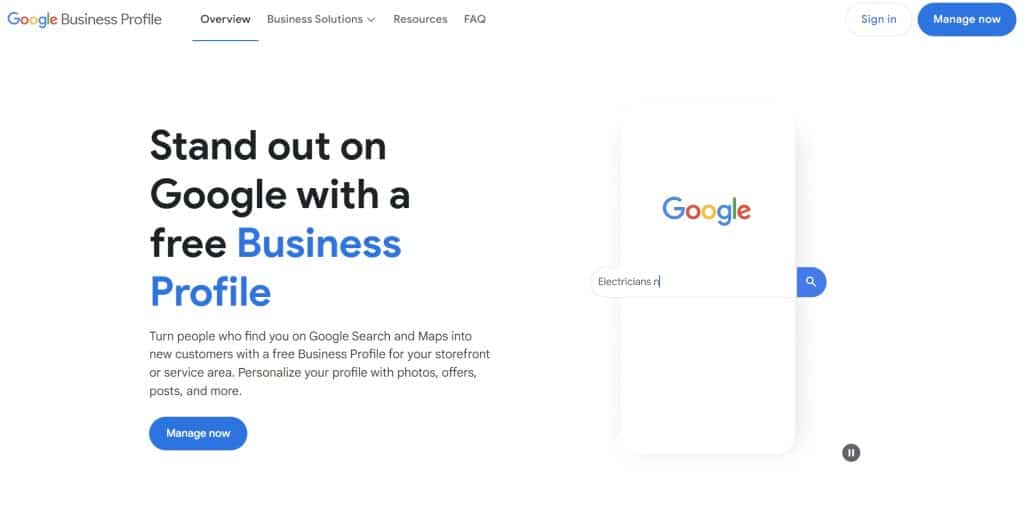
Profil d'entreprise de Google est la plateforme la plus importante pour toute entreprise. Elle vous permet d'apparaître en bonne place dans Google Search et Maps, qui sont les premiers endroits où la plupart des gens se rendent lorsqu'ils recherchent des produits et des services locaux.
En réclamant et en optimisant votre fiche d'entreprise locale sur Google, vous fournissez à vos clients potentiels des informations clés telles que votre adresse, votre numéro de téléphone, vos heures d'ouverture et des photos de votre entreprise. De plus, vous vous engagez auprès d'eux en répondre à vos avis Google.
En publiant des mises à jour régulières, en présentant des offres spéciales et en ajoutant vos produits et services, vous établissez une relation plus étroite avec votre public.
Dans l'ensemble, le fait de disposer d'un profil professionnel Google bien géré augmente considérablement vos chances d'être trouvé par des clients locaux et génère davantage de trafic vers votre entreprise. C'est sans doute ce qui fait de Google le meilleur site gratuit de référencement d'entreprises.
📍 Pourquoi c'est important : Le profil d'entreprise Google est la base de référencement local, ce qui influe directement sur votre visibilité dans Google Search et Maps.
S'inscrire à un service de profil d'entreprise Google avec accès à l'API
La meilleure façon d'utiliser pleinement votre profil Google Business est de vous inscrire sur une plateforme tierce qui dispose d'une intégration API directe avec Google Business.
L'une de ces options est EmbedSocialet elle présente de nombreux avantages :
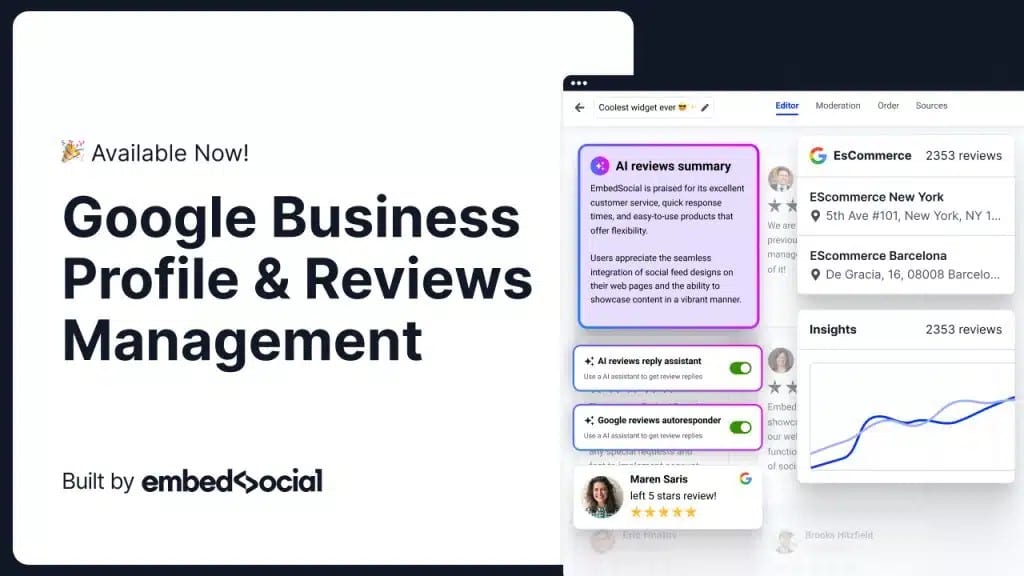
- Recueillir des avis de partout - si vous souhaitez obtenir automatiquement des avis sur l'ensemble de l'internet, EmbedSocial s'intègre à toutes les plateformes d'avis les plus populaires ;
- Répondre automatiquement aux commentaires des clients - vous obtenez un Autorépondeur pour l'évaluation de Google pour envoyer des réponses personnalisées en fonction du nombre d'étoiles ;
- Affichez les commentaires de vos clients - créer et mettre en valeur des Badges d'évaluation Google et des widgets avec des visuels captivants ;
- Générer des rapports d'évaluation Google - obtenir des informations très précieuses sur vos produits, vos services et les performances globales de votre entreprise grâce aux rapports d'évaluation ;
- Planifiez des posts sur votre profil d'entreprise - créer facilement et planifier divers posts sur le profil Google Business, Le site web de l'Union européenne est un outil de travail qui permet de garder son profil actif et pertinent ;
- Modification en masse de vos informations sur les GBP - mettre à jour les informations commerciales de tous vos établissements en une seule fois à partir d'un tableau de bord unique.
En plus de tout ce qui précède, nous offrons également de puissants outils de gestion de l'optimisation des moteurs de recherche qui maintiendront votre site Web à jour. citations locales et votre classement est plus élevé que celui de vos concurrents.
Voici tous les outils de référencement que nous proposons aux entreprises locales :
- Obtenir les meilleurs mots-clés - examinez tous les mots-clés utilisés par les internautes pour trouver votre entreprise sur Google et votre rang sur Google pour chacun d'entre eux ;
- Découvrez votre rang dans la recherche locale - voir comment vous vous situez par rapport aux autres sur un carte thermique du référencement local;
- Mise à jour à distance de vos citations locales - mettre à jour rapidement vos citations locales sur tous les sites de référencement populaires, tels que Google, Yelp, Apple Maps et Bing Places ;
- Optimisez votre profil pour un meilleur référencement - revoir les solutions rapides pour améliorer votre classement en matière de référencement local, telles que la mise à jour de vos informations, l'ajout de photos et la publication d'autres informations.
Donc, si vous cherchez à stimuler votre Google Maps SEO (et vous devriez le faire !), vous aurez certainement besoin d'outils comme ceux-ci, car ils vous permettent de garder le contrôle !
2. Bing Places for Business
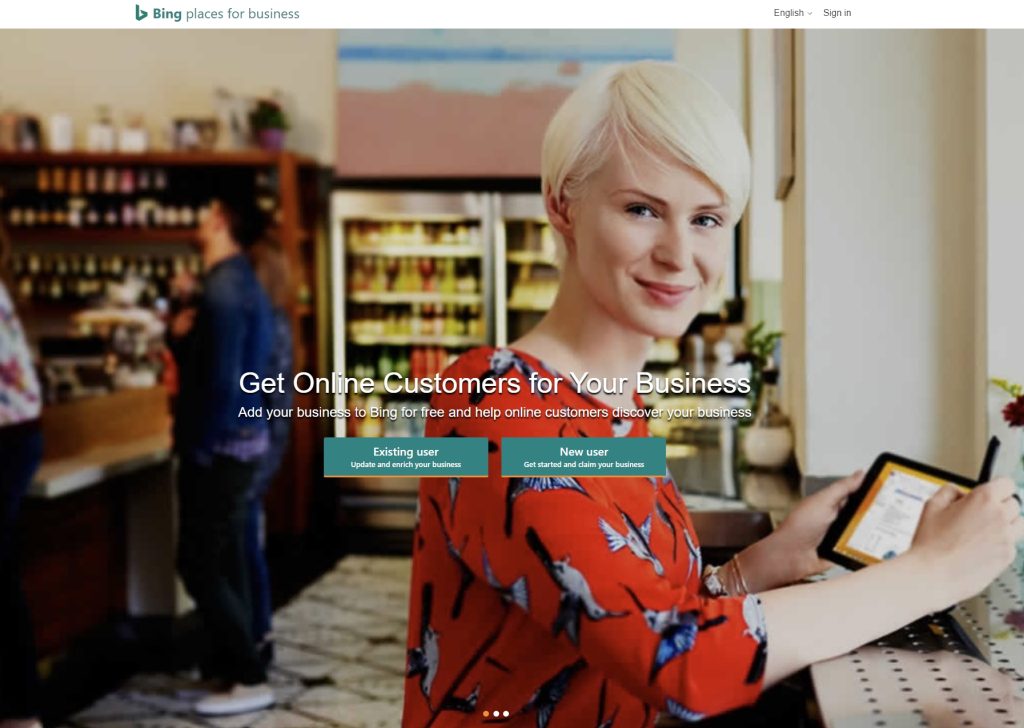
Bing Places for Bussiness est une plateforme importante pour les entreprises qui souhaitent atteindre les utilisateurs de Microsoft, car Bing est le moteur de recherche par défaut de Windows et, bien que sa part de marché soit inférieure à celle de Google, il attire encore des millions de recherches quotidiennes.
Bing Places for Business vous permet également de fournir des informations détaillées sur votre entreprise, notamment des coordonnées, des photos et des offres de services. De plus, il s'intègre à Bing Maps, ce qui permet aux clients locaux de trouver facilement votre emplacement physique.
📍 Pourquoi c'est important : Bing Places for Business capte des millions d'utilisateurs de Windows qui utilisent Bing comme moteur de recherche par défaut.
3. Apple Maps
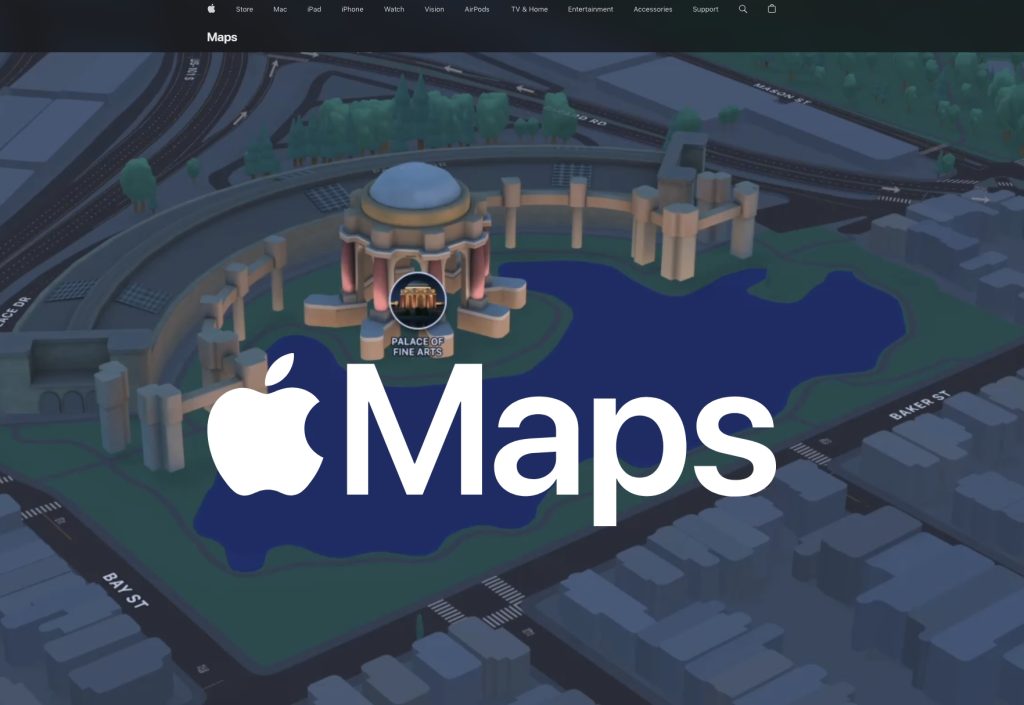
Apple Maps est l'outil de navigation par défaut de tous les appareils iOS et Mac, ce qui en fait une plateforme essentielle pour les entreprises qui souhaitent atteindre les utilisateurs d'Apple.
En inscrivant votre entreprise sur Apple Maps via la plateforme Apple Business Connect, vous vous assurez que les utilisateurs d'Apple peuvent facilement trouver votre emplacement, obtenir un itinéraire et consulter vos heures d'ouverture. De plus, Apple détient actuellement la majorité des parts de marché aux États-Unis.
Apple Maps est particulièrement important pour les entreprises situées dans des zones urbaines où les clients utilisent leurs appareils mobiles pour naviguer. En outre, les utilisateurs peuvent trouver des avis et des photos, ce qui leur permet d'obtenir des informations plus précieuses avant même de se rendre sur place.
Pour les entreprises qui envisagent de s'intégrer à l'écosystème Apple, vous pouvez en savoir plus sur l'utilisation d'un Mac dans le cadre de vos activités professionnelles. ici.
📍 Pourquoi c'est important : Apple Maps relie votre entreprise à la vaste base d'utilisateurs iOS qui dépendent du système de navigation natif d'Apple.
4. Yelp
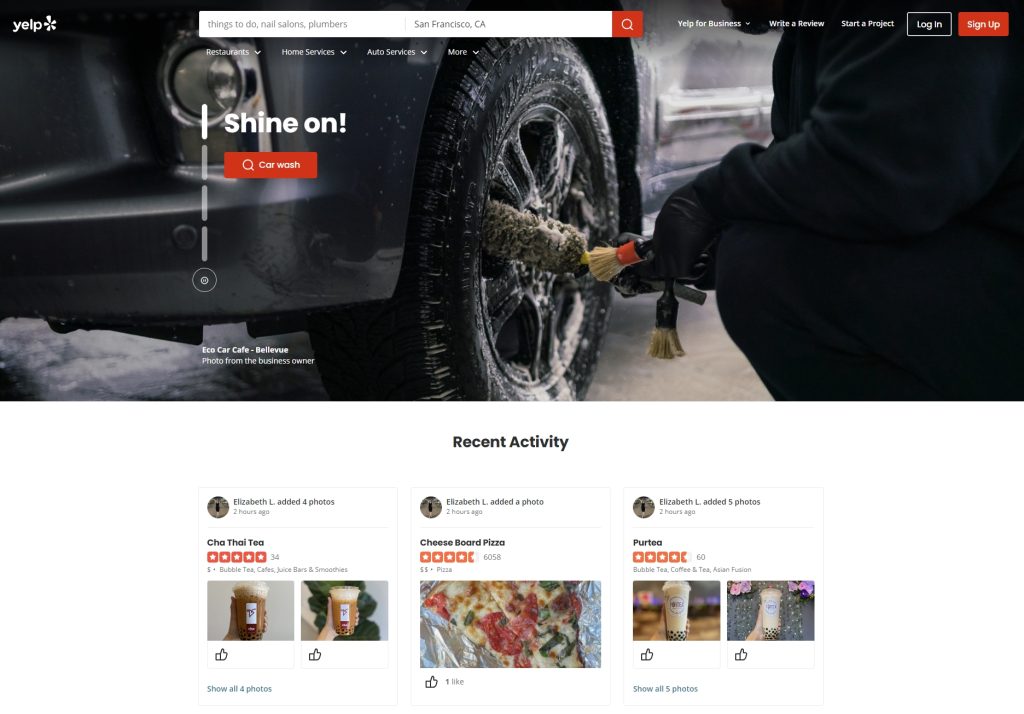
Yelp est la plateforme de référence pour les consommateurs qui recherchent des avis fiables avant de choisir une entreprise, et une forte présence sur Yelp peut grandement influencer les décisions des clients.
Après tout, de nombreuses personnes s'appuient sur les avis de leurs pairs pour évaluer la qualité des services ou des produits. En revendiquant votre page professionnelle Yelp, vous pouvez gérer la façon dont votre entreprise est présentée et interagir avec les clients par le biais des réponses aux commentaires.
Une fois que vous avez créé un profil, encourager les clients satisfaits à laisser des commentaires positifs peut augmenter votre note, améliorer votre réputation et attirer davantage de visiteurs.
Notez que Yelp propose également des options publicitaires pour accroître votre visibilité, mais même l'inscription gratuite de base peut être un outil puissant pour les entreprises locales.
📍 Pourquoi c'est important : Yelp aide les consommateurs à prendre des décisions grâce à des avis de pairs fiables et à une autorité de domaine élevée dans le domaine de la recherche locale.
5. Page d'entreprise Facebook
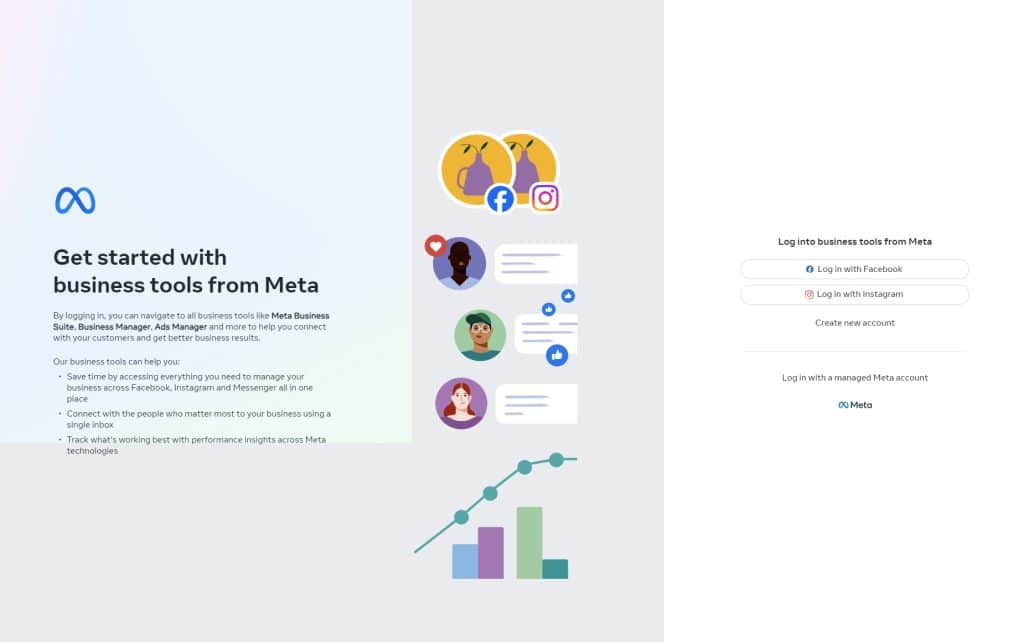
A Page professionnelle Facebook est un outil puissant pour communiquer avec les clients sur l'une des plus grandes plateformes de médias sociaux.
Facebook est une plateforme d'interaction sociale et un acteur majeur de la recherche locale, car de nombreux utilisateurs se tournent vers Facebook pour trouver des informations sur les entreprises.
Ainsi, en créant une page professionnelle, vous pouvez fournir des informations essentielles telles que votre adresse, votre numéro de téléphone et vos heures d'ouverture. Facebook vous permet également d'interagir directement avec vos clients par le biais de commentaires, de messages et d'évaluations.
Enfin, les outils publicitaires de Facebook vous permettent d'atteindre un public ciblé, ce qui en fait une plateforme essentielle pour la notoriété de la marque et l'engagement des clients.
📍 Pourquoi c'est important : La page professionnelle Facebook fusionne l'engagement social et la découverte locale, vous aidant à atteindre vos clients là où ils interagissent déjà quotidiennement.
6. Bureau d'éthique commerciale
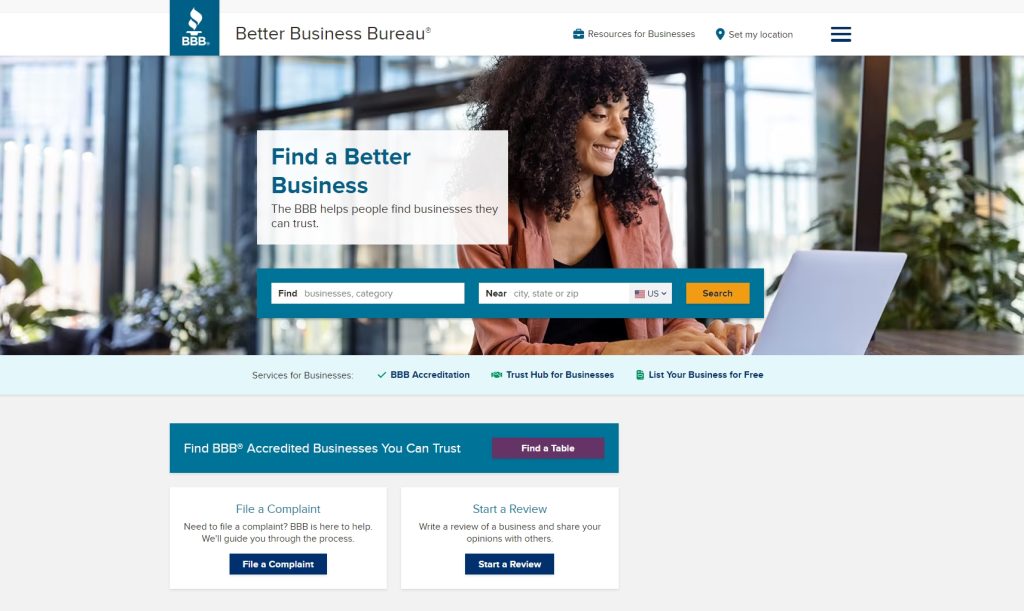
Inscrire votre entreprise sur la liste de l Bureau d'éthique commerciale (BBB) peut considérablement renforcer votre crédibilité, car le BBB est l'une des organisations de protection des consommateurs les plus fiables aux États-Unis, et de nombreux clients vérifient les évaluations du BBB avant de décider de s'engager avec une entreprise.
En étant répertorié et accrédité par le BBB, vous indiquez aux clients potentiels que votre entreprise est digne de confiance et qu'elle s'engage à maintenir des normes de service élevées.
Sans oublier que l'accréditation du BBB peut également améliorer votre référencement local, car les moteurs de recherche donnent souvent la priorité aux annuaires réputés et bien établis dans les résultats de recherche.
📍 Pourquoi c'est important : Le Better Business Bureau renforce la crédibilité et la confiance grâce à des listes vérifiées et à la résolution des plaintes des clients.
7. Pages jaunes
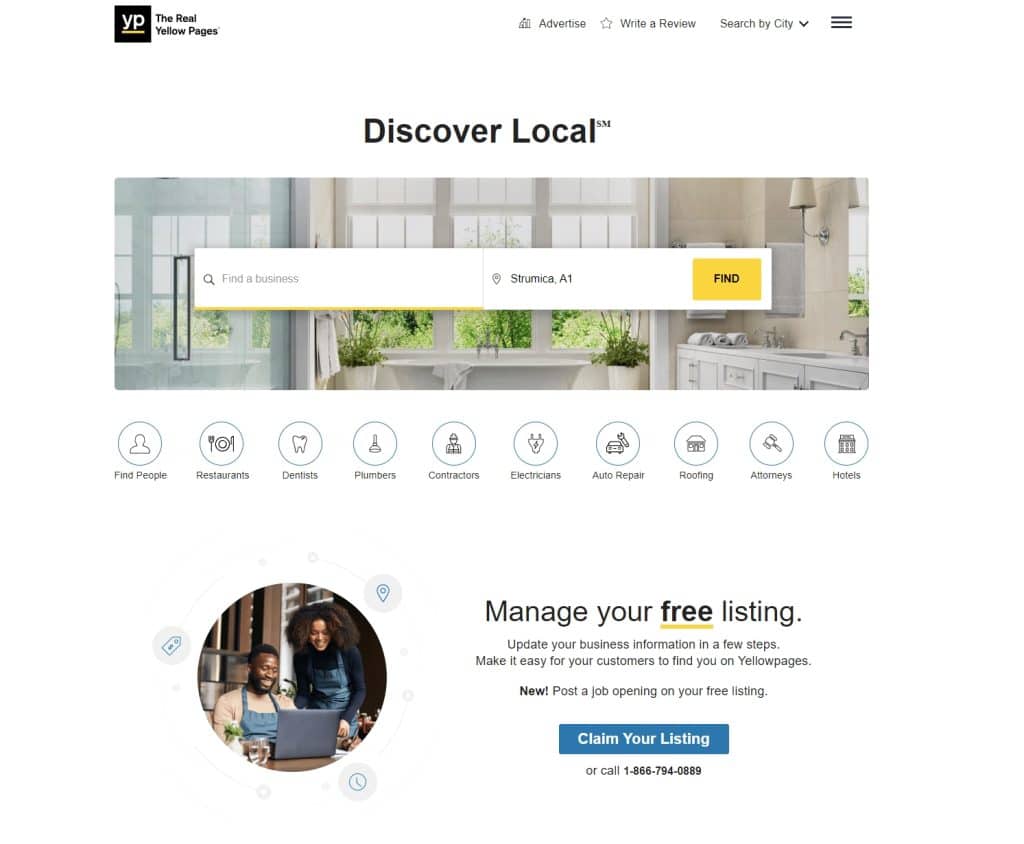
Le Pages Jaunes est passé d'un annuaire imprimé classique à une plateforme en ligne complète et, à ce titre, il est toujours très populaire pour trouver des entreprises locales.
Une inscription dans les Pages Jaunes vous permet d'atteindre un large public qui n'utilise peut-être pas aussi fréquemment d'autres plateformes numériques. En outre, la version en ligne des Pages Jaunes comprend des fonctionnalités telles que des avis de clients, des descriptions d'entreprises et la possibilité d'ajouter des photos.
Tous ces éléments peuvent contribuer à améliorer votre visibilité et, bien que sa base d'utilisateurs soit plus âgée, il reste un outil précieux pour les entreprises qui cherchent à atteindre un public diversifié.
📍 Pourquoi c'est important : Les Pages Jaunes restent utiles pour atteindre les populations plus âgées qui se fient encore aux annuaires locaux bien établis.
8. Manta
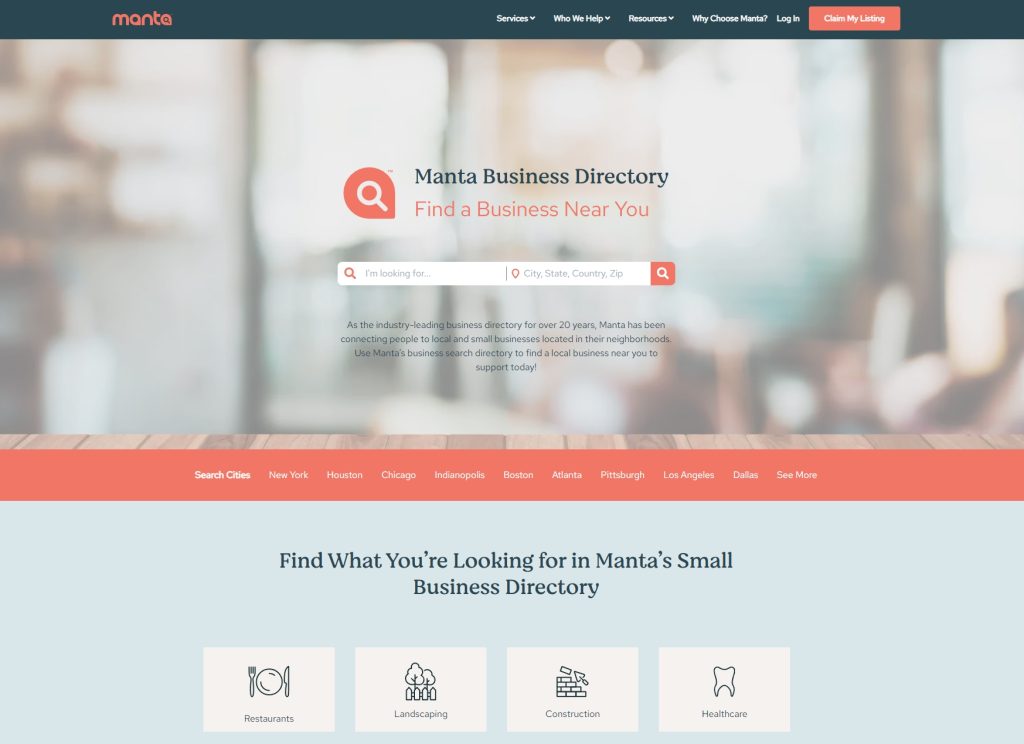
Manta est un annuaire qui se concentre sur les petites entreprises, offrant des outils pour les aider à développer leur présence en ligne. En tant que tel, un listing d'entreprise Manta vous permet d'entrer en contact avec un large public de propriétaires de petites entreprises et de consommateurs.
La plateforme offre également des fonctionnalités supplémentaires telles que des conseils aux entreprises, des possibilités de mise en réseau et des ressources marketing adaptées aux petites entreprises.
Par conséquent, en inscrivant votre entreprise sur Manta, vous augmentez votre visibilité dans les recherches locales et vous accédez à une communauté de propriétaires d'entreprises partageant les mêmes idées.
📍 Pourquoi c'est important : Manta se concentre sur les petites entreprises et leur offre une visibilité dans une communauté de niche d'entrepreneurs et de consommateurs.
9. Superpages
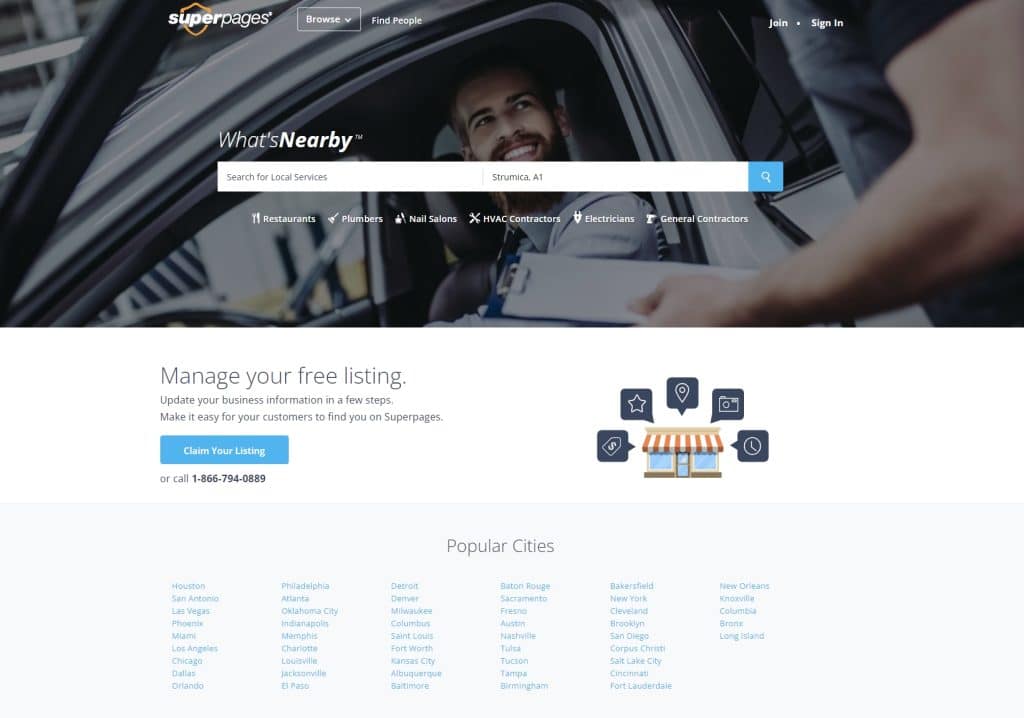
Superpages est un autre annuaire bien établi qui aide les entreprises à atteindre les consommateurs locaux. Comme les Pages Jaunes, il est passé d'un format imprimé traditionnel à une plateforme numérique, ce qui permet aux consommateurs de trouver plus facilement des entreprises en ligne.
La plateforme propose des listes gratuites où vous pouvez indiquer vos coordonnées, vos heures d'ouverture et vos services, ce qui est particulièrement utile pour les entreprises situées dans de petites communautés ou celles qui cherchent à attirer un public local, car elle se concentre sur des zones spécifiques.
📍 Pourquoi c'est important : Superpages renforce votre présence dans les communautés locales grâce à un annuaire établi de longue date et axé sur les régions.
10. Angi (anciennement Angie's List)
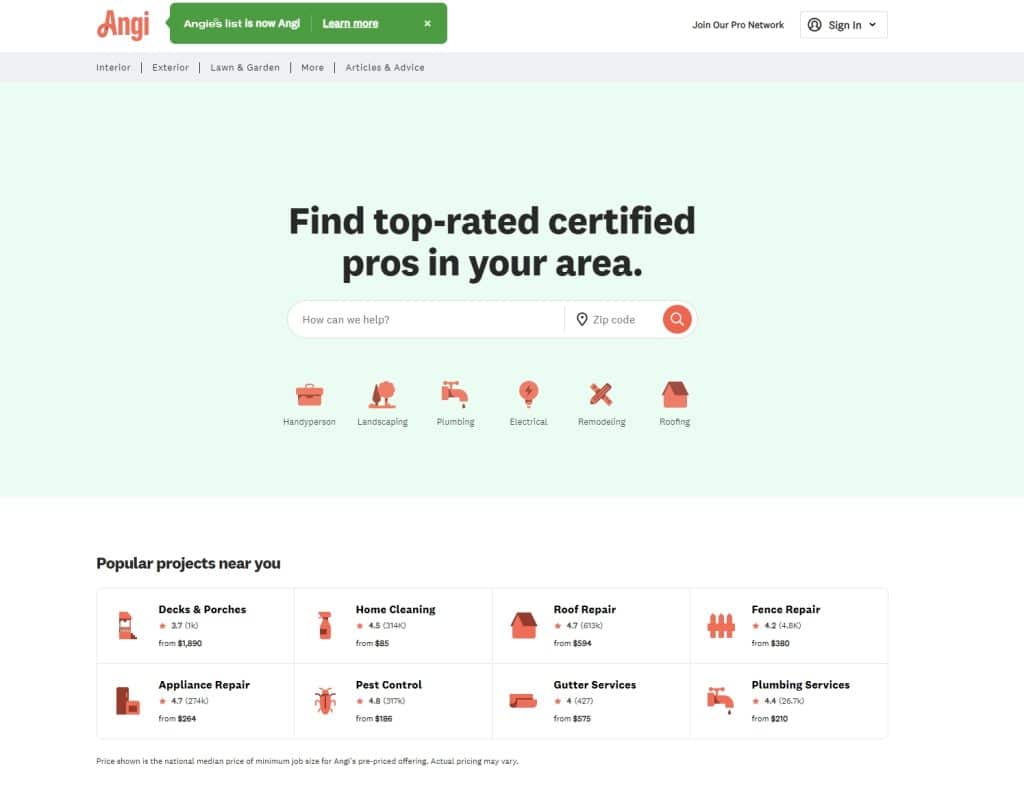
Angianciennement connu sous le nom de Angie's List, est une plateforme de confiance pour les entreprises de services, telles que les plombiers, les couvreurs, les électriciens et d'autres professionnels similaires.
Angi permet aux clients de trouver et d'évaluer les prestataires de services locaux, et les entreprises qui ont de bonnes évaluations sont souvent mises en avant dans les résultats de recherche.
Ainsi, si vous possédez une entreprise de services, l'inscrire sur Angi peut vous aider à atteindre un public très ciblé qui recherche spécifiquement vos services.
En outre, Angi propose des outils de gestion des rendez-vous, des paiements et des communications avec les clients, ce qui en fait une plateforme complète pour les professionnels des services.
📍 Pourquoi c'est important : Angi (anciennement Angie's List) met en relation des professionnels des services avec des clients locaux prêts à acheter et recherchant des prestataires de confiance.
11. Tripadvisor
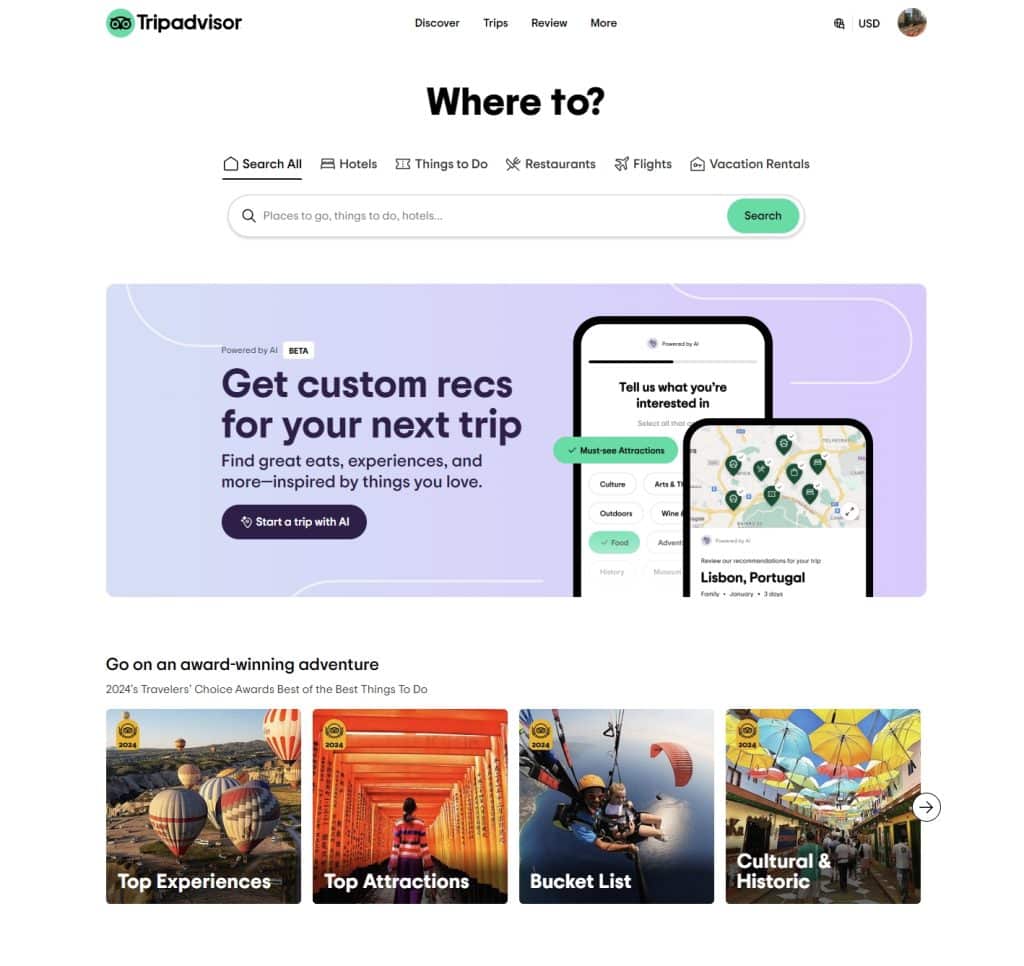
Pour les secteurs de l'hôtellerie et du tourisme, Tripadvisor est une liste incontournable. La plateforme est utilisée par des millions de voyageurs dans le monde entier pour trouver des hôtels, des restaurants, des attractions, etc.
Une forte présence sur Tripadvisor peut générer un trafic et des réservations importants, en particulier si votre entreprise dispose d'un grand nombre d'adresses. critiques positives.
La plateforme vous permet de publier des photos, de répondre aux commentaires et de mettre à jour votre liste avec des offres spéciales, ce qui renforce votre attrait. Que vous soyez un hôtel, un restaurant ou un voyagiste, Tripadvisor est essentiel pour toucher les voyageurs.
📍 Pourquoi c'est important : TripAdvisor influence les achats liés aux voyages en se plaçant en tête des recherches d'hôtels, de restaurants et d'attractions.
12. Foursquare pour les entreprises
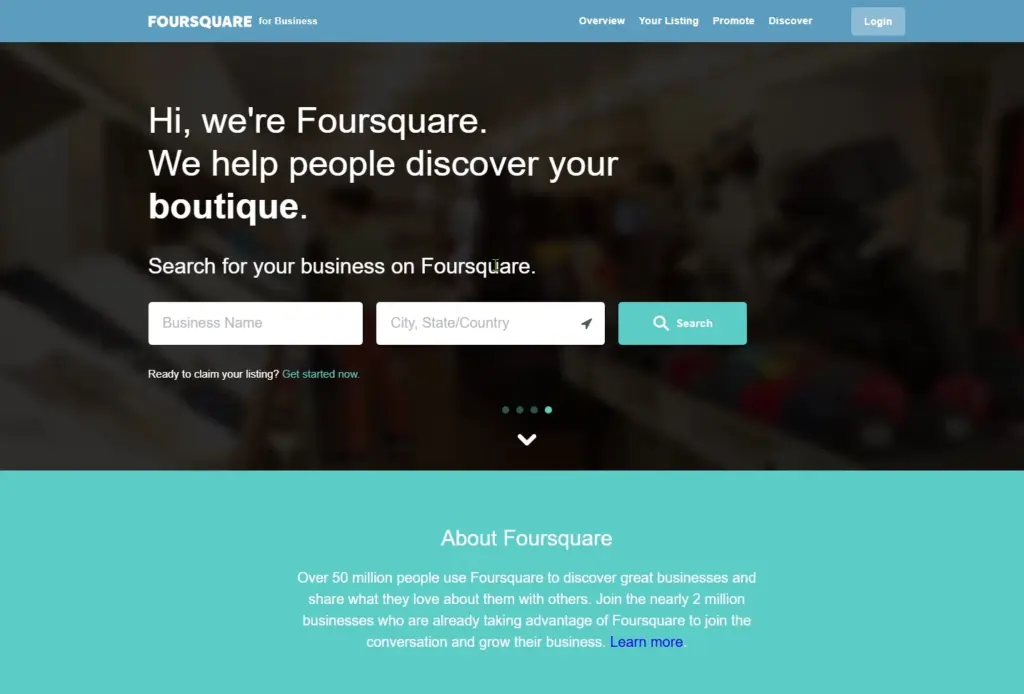
Foursquare pour les entreprises aide les marques à entrer en contact avec des clients proches grâce à des données de localisation précises et à des outils de découverte. Cette plateforme alimente la recherche locale pour de nombreuses applications majeures et permet aux utilisateurs de trouver des lieux en fonction de leur activité en temps réel et de leurs préférences.
En inscrivant votre entreprise sur Foursquare, vous la rendez accessible à un réseau d'applications et de services qui utilisent l'API Places de Foursquare, tels qu'Uber et Apple Maps, ce qui étend votre portée bien au-delà de l'audience de l'application native.
Une fois votre entreprise déclarée, vous pouvez ajouter des détails précis tels que les informations NAP, les horaires, les catégories et les photos, et les mettre à jour si nécessaire. La plateforme vous permet également de consulter des analyses sur les habitudes des visiteurs, les heures de pointe et les caractéristiques démographiques des clients.
📍 Pourquoi c'est important : Les données de Foursquare alimentent des milliards de recherches basées sur l'emplacement chaque mois, ce qui signifie que votre inscription influe sur la visibilité dans plusieurs écosystèmes, et non dans un seul.
13. MapQuest
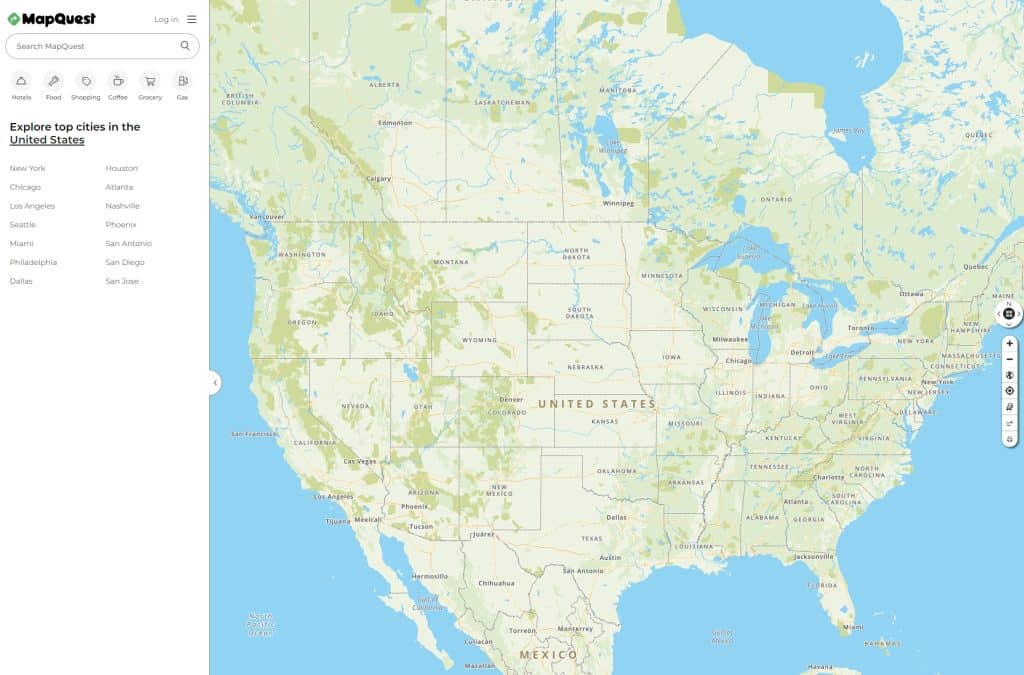
Dernier point, mais non des moindres MapQuest, Il s'agit d'une plateforme précieuse pour les entreprises qui cherchent à améliorer leur référencement local, même si elle n'est pas aussi populaire que Google Maps.
L'inscription de votre entreprise sur MapQuest permet aux clients utilisant cette plate-forme de trouver facilement votre emplacement, d'obtenir un itinéraire et de consulter les commentaires de vos clients.
Les entreprises peuvent également ajouter des photos, ce qui les rend plus attrayantes pour les clients potentiels. Alors, pourquoi ne pas couvrir tous vos besoins en matière de cartographie et de navigation en ligne en veillant à ce que l'emplacement de votre entreprise soit également ajouté à MapQuest ?
📍 Pourquoi c'est important : MapQuest soutient votre présence sur les plates-formes de navigation alternatives utilisées par des millions de conducteurs chaque mois.
10 bonnes pratiques pour une gestion optimale des listes d'entreprises locales
Le référencement efficace des entreprises étant essentiel pour maximiser votre visibilité en ligne, il convient de suivre quelques pratiques éprouvées pour tirer le meilleur parti de tous les sites de référencement gratuits :
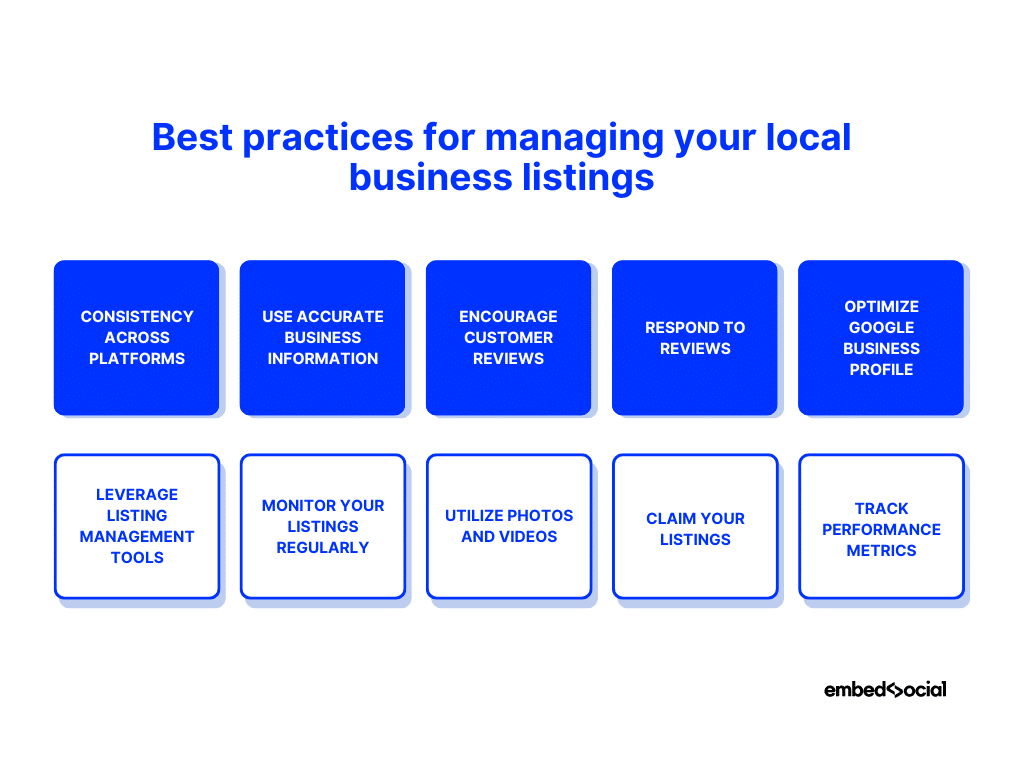
- Cohérence entre les plateformesAssurez-vous que le nom, l'adresse et le numéro de téléphone (NAP) de votre entreprise sont identiques dans tous les annuaires ;
- Utiliser des informations commerciales exactes-mettre régulièrement à jour les coordonnées de votre entreprise, y compris les heures d'ouverture, afin de garantir l'exactitude des informations à tout moment ;
- Encourager les commentaires des clients-demande active examens en ligne de clients satisfaits afin de renforcer votre réputation en ligne et d'améliorer le référencement local ;
- Répondre aux critiques-s'engager dans des actions positives et critiques négatives pour montrer que vous appréciez les commentaires des clients et que vous vous engagez à améliorer vos services ;
- Optimiser le profil professionnel Google-Mettre à jour et optimiser toutes les informations et tous les éléments visuels de vos profils Google Business, en particulier vos attributs GBP ;
- Exploiter les outils de gestion des listes-utiliser des outils pour gérer et mettre à jour efficacement vos inscriptions dans plusieurs annuaires ;
- Surveillez régulièrement vos inscriptions-vérifier fréquemment l'exactitude de vos annonces et répondre rapidement à toute modification ou à tout commentaire de la part des clients ;
- Utiliser des photos et des vidéos-ajoutez des images et des vidéos de haute qualité à vos annonces pour les rendre plus attrayantes et plus informatives pour les clients potentiels ;
- Réclamez vos annoncesAssurez-vous que vous avez revendiqué vos listes d'entreprises sur toutes les plateformes pertinentes afin de garder le contrôle de votre présence en ligne ;
- Suivre les indicateurs de performance-Utilisez des outils d'analyse pour surveiller les performances de vos annonces et adapter votre stratégie en fonction des besoins pour obtenir de meilleurs résultats.
En suivant ces bonnes pratiques, vous conserverez des listes d'entreprises précises et cohérentes, ce qui vous aidera à renforcer votre présence en ligne et à entrer en contact avec un plus grand nombre de clients.
Ceci étant dit, des informations incohérentes d'une plateforme à l'autre est un écueil courant dans la gestion des listes d'entreprises locales. Il convient donc d'auditer régulièrement vos listes afin d'en préserver l'uniformité.
Un autre problème courant est négliger commentaires des clients. Ne pas répondre aux demandes négatives et critiques positives ou ne pas encourager les critiques peut nuire à votre réputation.
Enfin, de nombreux les entreprises négligent les petits annuaires, et passent ainsi à côté d'audiences ciblées qui pourraient générer des conversions et un avantage concurrentiel.
Conclusion : Placez des annonces d'entreprises gratuites partout et augmentez votre crédibilité !
Maintenir des listes d'entreprises locales exactes sur tous les sites d'inscription d'entreprises populaires est une tâche difficile. indispensable pour booster votre référencement et améliorer la confiance des clients.
En veillant à ce que votre entreprise soit répertoriée sur les principaux sites d'annonces locales tels que Google Business Profile, Yelp et d'autres, vous permettez à vos clients cibles de vous trouver beaucoup plus facilement.
Cependant, pour réussir, vous devez rester proactif dans la gestion de vos inscriptions dans les annuaires professionnels gratuits.
Ainsi, mettre à jour vos informations sur tous les sites de référencement pertinents lorsque vous effectuez un changement. En outre, tenez compte des commentaires des clients et utilisez des outils de suivi des performances. Ne négligez pas non plus les petits annuaires, qui vous permettent d'accéder à des publics très ciblés.
En suivant les meilleures pratiques décrites ci-dessus, vous poserez des bases solides pour attirer davantage de clients locaux et stimuler la croissance de votre entreprise en 2025 et au-delà.
Vous savez, vous pouvez utiliser l'agent IA avancé d'EmbedSocial qui répondra aux questions suivantes commentaires des clients en votre nom, en utilisant la voix de votre marque ! Essayez-le dès aujourd'hui!
FAQ sur les listes d'entreprises locales
Qu'est-ce qu'une liste d'entreprises locales ?
Les listes d'entreprises locales sont des profils en ligne qui contenir des informations essentielles sur votre entreprise, L'entreprise doit y être répertoriée, avec son nom, son adresse, son numéro de téléphone et ses heures d'ouverture. Ces listes apparaissent dans les moteurs de recherche et les annuaires, ce qui permet aux clients locaux de trouver facilement votre entreprise.
Comment créer une fiche d'entreprise locale sur Google ?
Pour créer une fiche d'entreprise locale sur Google, rendez-vous à l'adresse suivante Profil d'entreprise Google, Pour cela, connectez-vous à l'aide de votre compte Google et suivez les instructions pour saisir les informations relatives à votre entreprise. Une fois que vous aurez vérifié votre entreprise, votre fiche sera visible dans Google Search et Maps.
Pourquoi est-il important de mettre à jour régulièrement mes listes d'entreprises ?
En mettant régulièrement à jour vos listes d'entreprises, vous vous assurez que les clients et les moteurs de recherche disposent d'informations exactes sur votre entreprise, ce qui permet d'éviter toute confusion de la part des clients, d'améliorer votre image de marque et de renforcer votre image de marque. référencement local, et garantit que votre entreprise reste digne de confiance et accessible.
Quelle est la meilleure plateforme de référencement local pour les entreprises ?
Votre profil professionnel Google est largement considéré comme la meilleure plateforme de référencement local en raison de sa prédominance dans les résultats de recherche et de son intégration à Google Maps. Sans lui, vous ne pouvez pas vraiment améliorer votre visibilité locale, atteindre un large public ou accroître vos bénéfices.
Comment ajouter gratuitement une fiche d'entreprise ?
Tout d'abord, vous devez consulter tous les sites d'inscription gratuite d'entreprises aux États-Unis (ou dans un autre pays). Une fois que vous les aurez trouvés, vous pourrez créer votre site web en fournissant les informations de base sur votre entreprise, telles que votre nom, votre adresse et vos numéros de téléphone. Vous devrez répéter la gestion des listes d'entreprises pour tous les sites.
